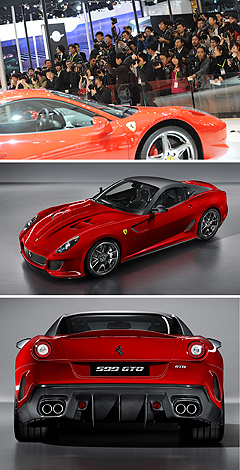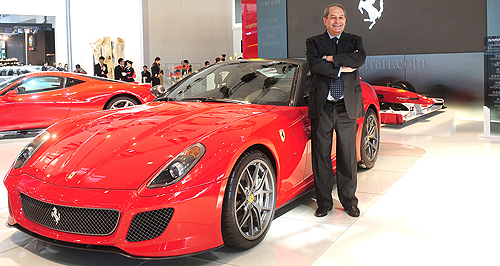Make / Model Search
Future models - Ferrari - 599 - GTOChinese women drive Ferrari salesBeijing debut: Ferrari CEO Amedeo Felisa unveils the 599 GTO at the Beijing motor show. Prancing Horse turns China red as cashed-up businesswomen favour Ferrari26 Apr 2010 By JOHN MELLOR in BEIJING Chinese women are turning out to be unique in the world when it comes to buying a Ferrari. In a by-product of 30 years of sustained economic growth which has created great prosperity for private businesses in the new economy, wealthy Chinese women are buying Ferraris at a rate four times greater than women in the West. Last year Ferrari sold 220 cars in China of which 44 were bought by women – 20 per cent of the total. Yet in the rest of the world women represent less than five per cent of Ferrari buyers. This is one aspect of the importance the Chinese market now represents to specialist car makers like Ferrari that can only ever have a small niche in any market. But, in the booming Chinese car market, Ferrari also floats up on the rising tide and this is helping to insulate the company from the opposite trend in the hugely important North American and European markets where sales were stagnating even before the GFC. Ferrari put its stamp on the Chinese market by choosing the Beijing Auto Show to launch the Ferrari 599 GTO – a car limited to a production run of 600 that will sell in Australia for around $800,000 and has a two year waiting list. Described by Australian importer, Neville Crichton as basically a road-going version of a track car, the unveiling of the GTO was presided over by the Ferrari CEO, Amedeo Felisa. Mr Felisa told Australian journalists in an exclusive interview that the company previewed the Ferrari 599 GTO in Beijing to underline the fact that China and Asia Pacific “have become really important for our Ferrari strategy in the future”. “When it came the time to present the GTO, of course due to the name we know it is a very important model and a very important car for us, so we say why not go there (Beijing) and show everyone that China and Asia-Pacific are very important to us.” So important, indeed, that last year Ferrari was the only sporty brand to keep growing in the Asia-Pacific.  Left: Chinese media lap up the Ferrari 599 GTO in Beijing. Below: Ferrari 599 GTO. Left: Chinese media lap up the Ferrari 599 GTO in Beijing. Below: Ferrari 599 GTO.Asia-Pacific sales last year were around 500 cars a year. Within that, greater China, including Taiwan and Hong Kong, was Ferrari’s biggest market. More than 220 cars were sold through 10 dealers in China, with 150 sales in Hong Kong and 50 cars in Taiwan. Back in 2004, Ferrari sold 65 cars in China its first year in the market. Ferrari sold 6200 worldwide cars last year and expects to sell about the same in 2010. The best year was 2008 with 6500 cars. Analysis of the Ferrari segment before the GFC shows a pool of 14,000 sales a year worldwide. Mr Felisa said the future of Ferrari lay in the lifestyle ambitions of the Chinese people. “We don’t see big possibilities (to increase sales) in Europe and we don’t see big possibilities in the US,” he said “But for sure we have not exploited the potential we have in Asia-Pacific as well as the Middle East and East Europe.” In 2009, Ferrari reduced production overall by four per cent, with US sales down 15 per cent and numbers in the Far East up five per cent. “Here we have the possibility of growth and last year, in spite of the fact that the economic situation is not a good one, we were able to increase volume here in Asia-Pacific,” he said. “So you can imagine that this is the part of the world where you can change our volumes. But we will be keeping to our numbers. We don’t have in mind to double or triple the numbers. We want to continue to grow if the market is in that direction.” Mr Felisa said he expected to sell more cars in China this year, even though a tax increase on cars in China had affected sales. But he said that Ferrari was conservative with its production because the company did not want to over-supply the market. Mr Felisa said that he believed Ferrari could potentially lift volumes in China from about 220 now to “probably go to 400 in three or four years”, but this would depend on the taxation policy and the politics of China. “Today in China, there are 400 to 500 millionaires and we have more than 200 a year buying our cars. As they are growing we are keeping up with them.” Mr Felisa said the Ferrari market would grow even more as more and more Chinese business people reached the income threshold necessary to be able to afford his cars. He said the most striking feature of the Chinese market was the much larger proportion of women Ferrari buyers compared with the rest of the world. “We have 20 per cent of women buying our cars compared with less than five per cent for the rest of the world,” he said. “If you look to the average age of customers who buy Ferrari’s in China it is 10 years less than in Europe. In China you have a lot of women running businesses and in a very, very tough way and they have the money and they can afford to buy a Ferrari. “It was a surprise for us because we were not expecting such a success on women but I think it is a condition of business here in China. “This is a completely new and growing market and the people who have the money or have started to do business are different to the Europe and the US. “There is not really much difference here between the men and the women doing business.” Mr Felisa said another difference in Chinese buyers compared to those in other markets was that they were “more extreme” when ordering interior trim materials than Europeans. Ferrari also sees a large potential growth for its brand business in China as Chinese consumers increasing embrace fashion and want to be associated with key lifestyle and high-image brands. Mr Felisa said this tied in with Ferrari’s conservative vehicle production policy of “moving on volumes but not pushing on volumes” of its cars. It would therefore also focus on leveraging more business in China from the high strength of the Ferrari brand. The Ferrari brand business includes merchandising and licensing of the Ferrari name. The brand business contributes about 20 per cent to the Ferrari operating profits – about 50 million euros a year. He said opening Ferrari’s bottom line up to business opportunities other than making cars was “an idea that works”, and that the company would continue to develop the concept in the Far East. But he warned that Ferrari would be happy to make money from the brand business but only if there was a positive impact on the brand and no negative impact on its reputation. “Today that is working. Again, we are not living without any restraint so we are not doing everything only to get money but only do things that will sustain the brand. “Twenty per cent of the operating result is good but we are not interested in going too much over if this will affect the brand.” Mr Felisa said the success of the brand business proved that the real value of the Ferrari business was in the brand, “and everything we do in the company is to sustain the brand".  Read moreAll future models Alfa Romeo Alfa Romeo Abarth Abarth Alpine Alpine Alpina Alpina Audi Audi Aston Martin Aston Martin BMW BMW Bentley Bentley Chery Chery Brabham Brabham Chrysler Chrysler Chevrolet Chevrolet Cupra Cupra Citroen Citroen DS DS Dodge Dodge Fiat Fiat Ferrari Ferrari Foton Foton Ford Ford Great Wall Great Wall FPV FPV Haval Haval GWM GWM Honda Honda Holden Holden Hummer Hummer HSV HSV Infiniti Infiniti Hyundai Hyundai Jaguar Jaguar Isuzu Isuzu Kia Kia Jeep Jeep Land Rover Land Rover Lamborghini Lamborghini Lexus Lexus LDV LDV Mahindra Mahindra Lotus Lotus Mazda Mazda Maserati Maserati Mercedes-AMG Mercedes-AMG McLaren McLaren MG MG Mercedes-Benz Mercedes-Benz Mitsubishi Mitsubishi Mini Mini Opel Opel Nissan Nissan Peugeot Peugeot Pagani Pagani Proton Proton Porsche Porsche Renault Renault Ram Ram Rover Rover Rolls-Royce Rolls-Royce Skoda Skoda Saab Saab SsangYong SsangYong Smart Smart Suzuki Suzuki Subaru Subaru Toyota Toyota Tesla Tesla Volvo VolvoMotor industry news |
Click to shareFerrari modelsResearch Ferrari All future models Alfa Romeo Alfa Romeo Abarth Abarth Alpine Alpine Alpina Alpina Audi Audi Aston Martin Aston Martin BMW BMW Bentley Bentley Chery Chery Brabham Brabham Chrysler Chrysler Chevrolet Chevrolet Cupra Cupra Citroen Citroen DS DS Dodge Dodge Fiat Fiat Ferrari Ferrari Foton Foton Ford Ford Great Wall Great Wall FPV FPV Haval Haval GWM GWM Honda Honda Holden Holden Hummer Hummer HSV HSV Infiniti Infiniti Hyundai Hyundai Jaguar Jaguar Isuzu Isuzu Kia Kia Jeep Jeep Land Rover Land Rover Lamborghini Lamborghini Lexus Lexus LDV LDV Mahindra Mahindra Lotus Lotus Mazda Mazda Maserati Maserati Mercedes-AMG Mercedes-AMG McLaren McLaren MG MG Mercedes-Benz Mercedes-Benz Mitsubishi Mitsubishi Mini Mini Opel Opel Nissan Nissan Peugeot Peugeot Pagani Pagani Proton Proton Porsche Porsche Renault Renault Ram Ram Rover Rover Rolls-Royce Rolls-Royce Skoda Skoda Saab Saab SsangYong SsangYong Smart Smart Suzuki Suzuki Subaru Subaru Toyota Toyota Tesla Tesla Volvo VolvoMotor industry news |











Facebook Twitter Instagram